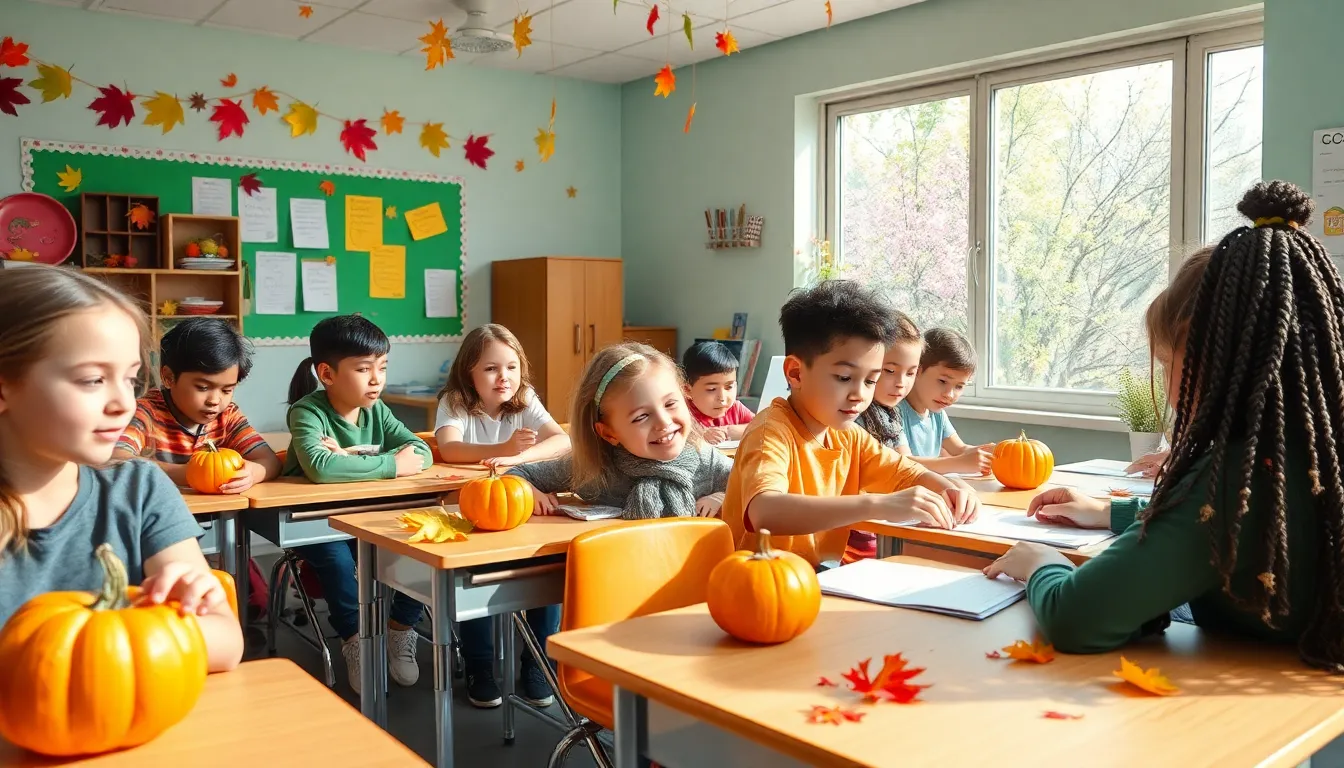Transforming a classroom into a vibrant learning space doesn’t have to be a chore. With seasonal classroom themes, educators can sprinkle a little magic into their teaching while keeping students engaged and excited. Imagine walking into a room decked out in autumn leaves or spring blooms—it’s like stepping into a Pinterest board come to life!
Table of Contents
ToggleOverview of Seasonal Classroom Themes
Seasonal classroom themes create dynamic learning atmospheres. These themes correspond to the annual changes in nature and holidays, providing unique opportunities for engagement. Autumn themes might include pumpkins and harvest celebrations, while winter themes can showcase snowflakes and holiday traditions.
Teachers often incorporate decorations that reflect each season. Fun items like colorful leaves, flowers, or themed bulletin boards enhance the visual appeal. Engaging students with seasonal art projects fosters creativity and aligns with the themes.
Curriculum connections strengthen the impact of seasonal themes. Language arts can incorporate seasonal stories, while science explores weather patterns through seasonal changes. Mathematics often integrates seasonal themes with real-world problems, such as calculating the number of days until spring break.
Seasonal themes also promote community and culture awareness. Celebrating festivals such as Halloween or Thanksgiving allows for discussions about cultural significance. These themes encourage respect and appreciation for diverse traditions.
Teachers benefit from planning ahead for each season. Organizing materials and activities in advance allows for a smoother transition. Establishing a rotational calendar helps educators prepare for upcoming themes effectively.
Using seasonal themes creates a positive classroom environment. Students experience excitement with new elements and activities throughout the year. Such themes not only enhance aesthetics but also enrich learning experiences for all students.
Importance of Seasonal Themes in Education
Seasonal themes play a crucial role in creating an engaging educational atmosphere. They promote active participation and foster a sense of connection among students.
Enhancing Engagement
Seasonal themes capture students’ interest by introducing dynamic visuals. Engaging decorations, like autumn leaves or spring flowers, draw attention and stimulate curiosity. Creative art projects aligned with the seasons encourage hands-on learning, making lessons more relevant and enjoyable. Themes also spark discussions that tie into real-world experiences. For example, a winter theme might incorporate discussions about weather patterns, enhancing understanding through observation. Teachers can incorporate seasonal books into reading sessions, increasing literacy skills while maintaining excitement. Overall, this method actively involves students, resulting in deeper comprehension.
Supporting Curriculum Objectives
Curriculum objectives seamlessly integrate with seasonal themes. Educators align seasonal content with standards across subjects to facilitate meaningful connections. For instance, autumn classrooms can host math activities involving counting and measuring pumpkins. In science, discussions on seasonal changes provide foundational knowledge about ecosystems. Language arts can include writing assignments where students describe holiday traditions, enhancing their communication skills. Utilizing seasonal themes fosters collaboration among various subjects, enriching the learning experience. Additionally, these themes encourage cultural awareness by incorporating diverse celebrations, allowing students to learn respect for different traditions. Through this approach, educators effectively meet curriculum objectives while enhancing students’ educational journeys.
Popular Seasonal Classroom Themes
Educators often find seasonal themes vital for creating an engaging classroom environment. Each season offers unique opportunities for interactive learning experiences and creative activities.
Fall-Themed Activities
Autumn presents a variety of engaging activities. Teachers can incorporate pumpkin-related math lessons, where students count and measure pumpkins. Creating autumn leaf art allows for a hands-on approach to art and science, discussing tree life cycles. Group discussions about harvest festivals can promote cultural awareness, enhancing students’ social studies understanding.
Winter Wonderland Ideas
Winter-themed activities encourage creativity and exploration. Snowflake craft projects can illustrate symmetry principles in math class. Teachers might explore seasonal traditions, such as holiday celebrations, fostering connections to diverse cultures. Incorporating winter science experiments, like temperature changes with ice, keeps students engaged while aligning with curriculum standards.
Spring Celebrations
Spring brings vibrant themes that energize classrooms. Planting seeds serves as an excellent science lesson on growth and life cycles, integrating hands-on activities. Seasonal poetry often explores themes of renewal and nature, boosting language skills. Organizing Earth Day activities can also emphasize environmental science, encouraging stewardship and sustainability awareness.
Summer Learning Adventures
Summer-themed lessons foster a sense of adventure. Units on ocean life allow exploration of marine biology through interactive lessons and field trips. Teachers can engage students in outdoor activities, promoting physical education and teamwork. Creating a summer reading program encourages literacy while allowing exploration of various genres, making learning fun and dynamic.
Implementation Strategies
Implementation of seasonal themes requires careful planning and creativity. Educators can enhance student engagement by integrating themes across subjects effectively.
Integrating Themes with Subjects
Integrating themes with subjects promotes a rich learning experience. Math can involve seasonal counting games, such as counting apples in fall activities. Language arts can include poetry tied to each season, fostering creativity. Science lessons might explore the life cycles of plants during spring or the effects of winter weather. History discussions can center around cultural traditions and celebrations related to each season. Moving from one theme to another requires clear connections, ensuring students understand the relevance in their studies. This approach aligns with educational standards while keeping lessons vibrant and engaging.
Creating Interactive Displays
Creating interactive displays enhances visual learning and student involvement. Seasonal decorations can bring the classroom to life, captivating students’ attention. Incorporating elements like interactive bulletin boards allows students to contribute their work, showing off projects related to seasonal themes. Students can engage in hands-on activities such as crafting autumn leaves or winter snowflakes to decorate displays. Combining technology with art, digital displays can showcase seasonal changes through videos or images. This not only reinforces learning concepts but also promotes collaboration among students as they share ideas and creativity. Engaging interactive displays stimulate excitement and curiosity throughout the academic year.
Conclusion
Embracing seasonal classroom themes can transform the educational experience for students. By incorporating vibrant decorations and engaging activities that reflect the changing seasons, educators can create a dynamic learning environment that sparks curiosity and creativity.
These themes not only enhance visual appeal but also foster collaboration across subjects, making learning more relevant and enjoyable. As teachers plan for each season, they can cultivate a classroom atmosphere that celebrates diversity and encourages students to connect with the world around them.
Ultimately, seasonal themes enrich the educational journey, making it an exciting adventure for both students and educators alike.





